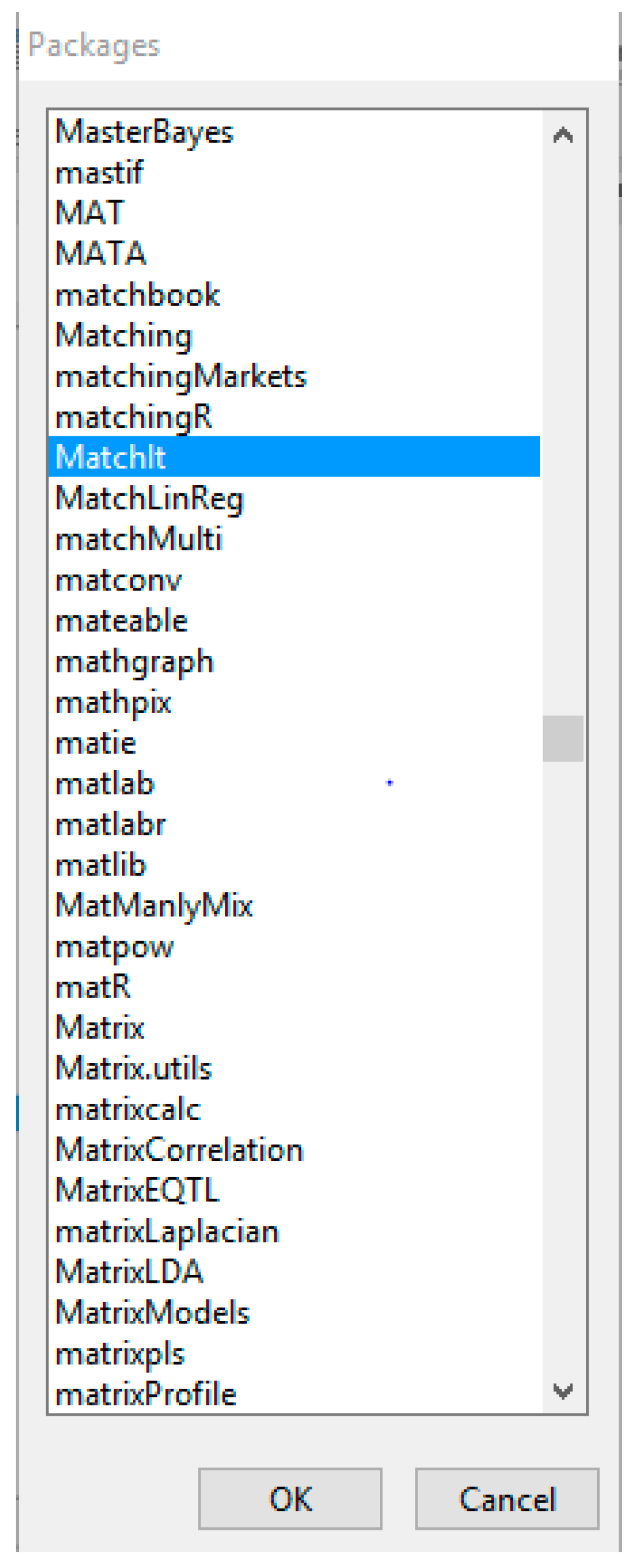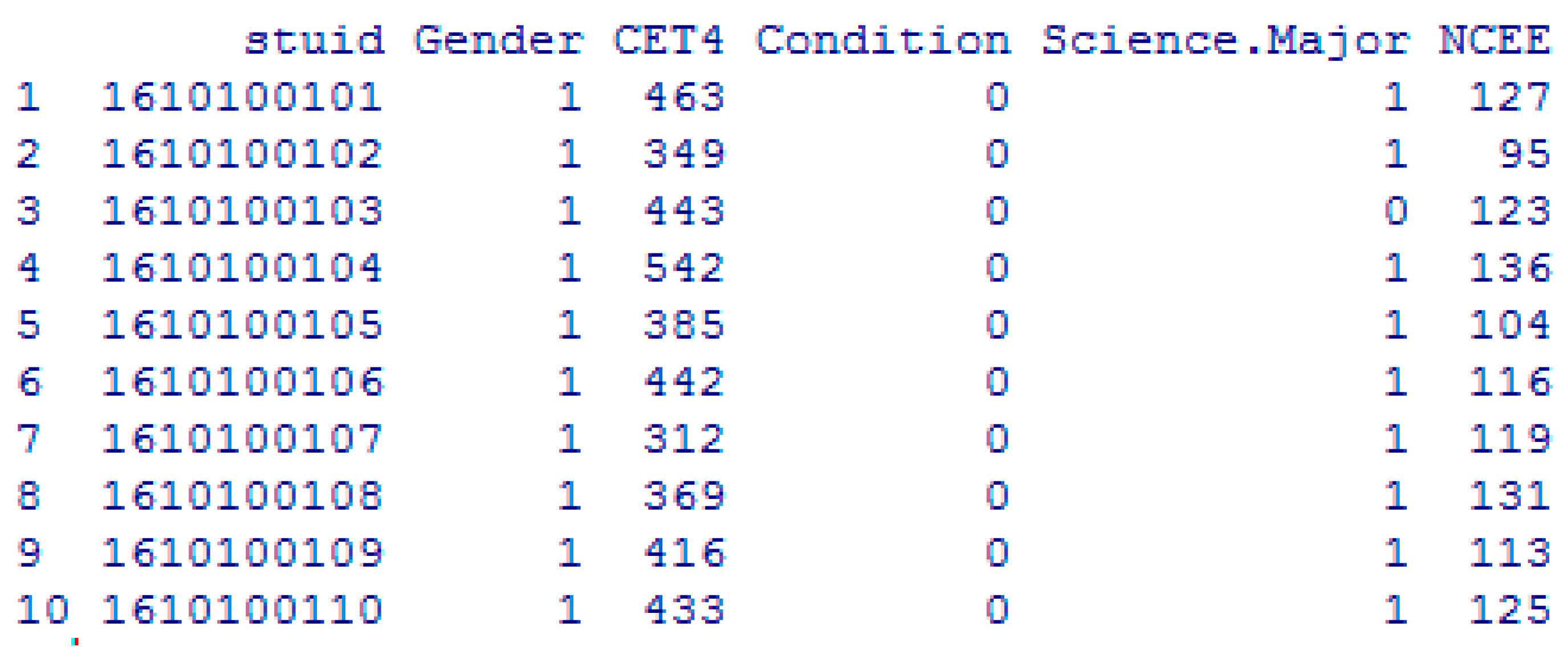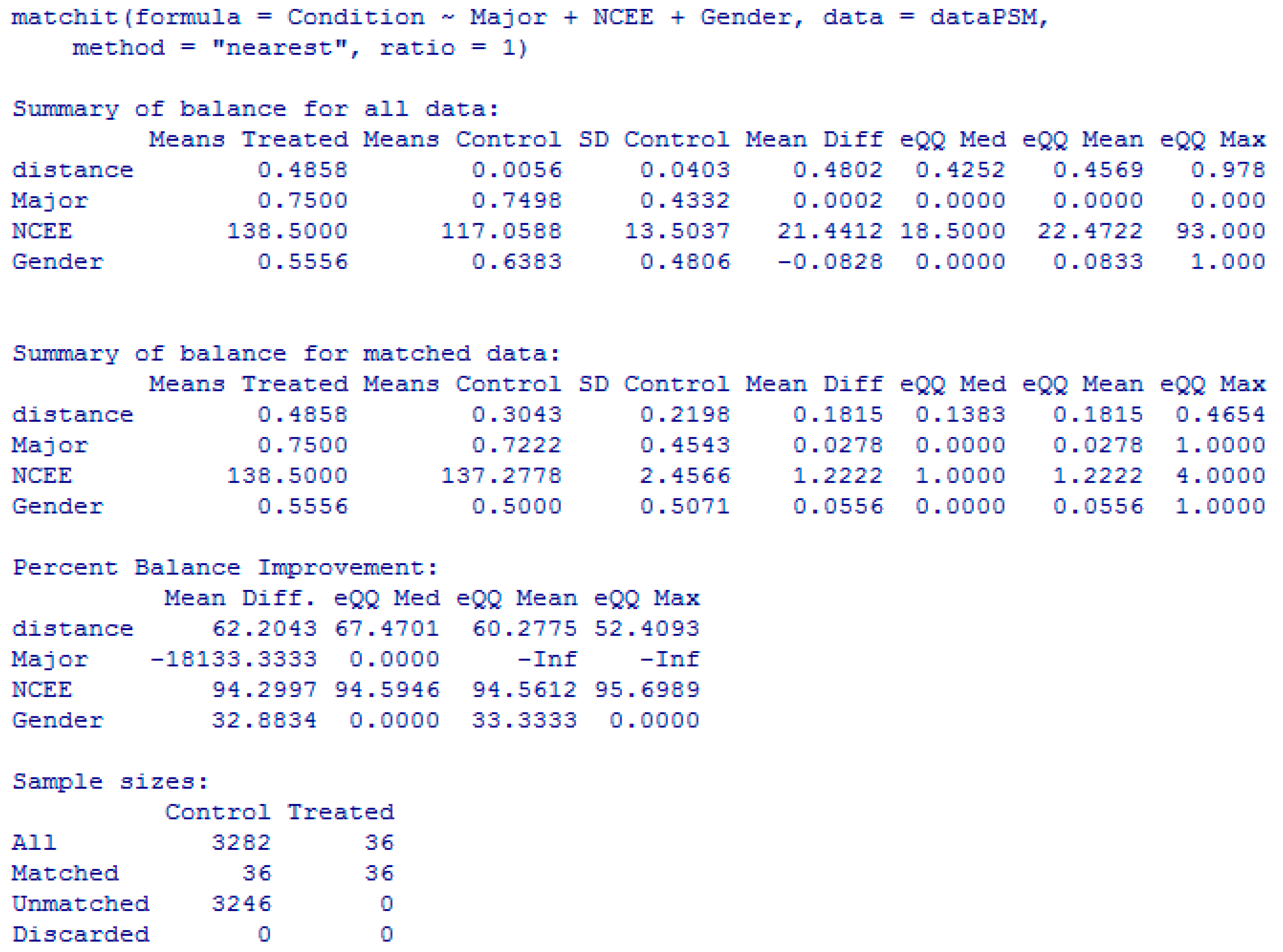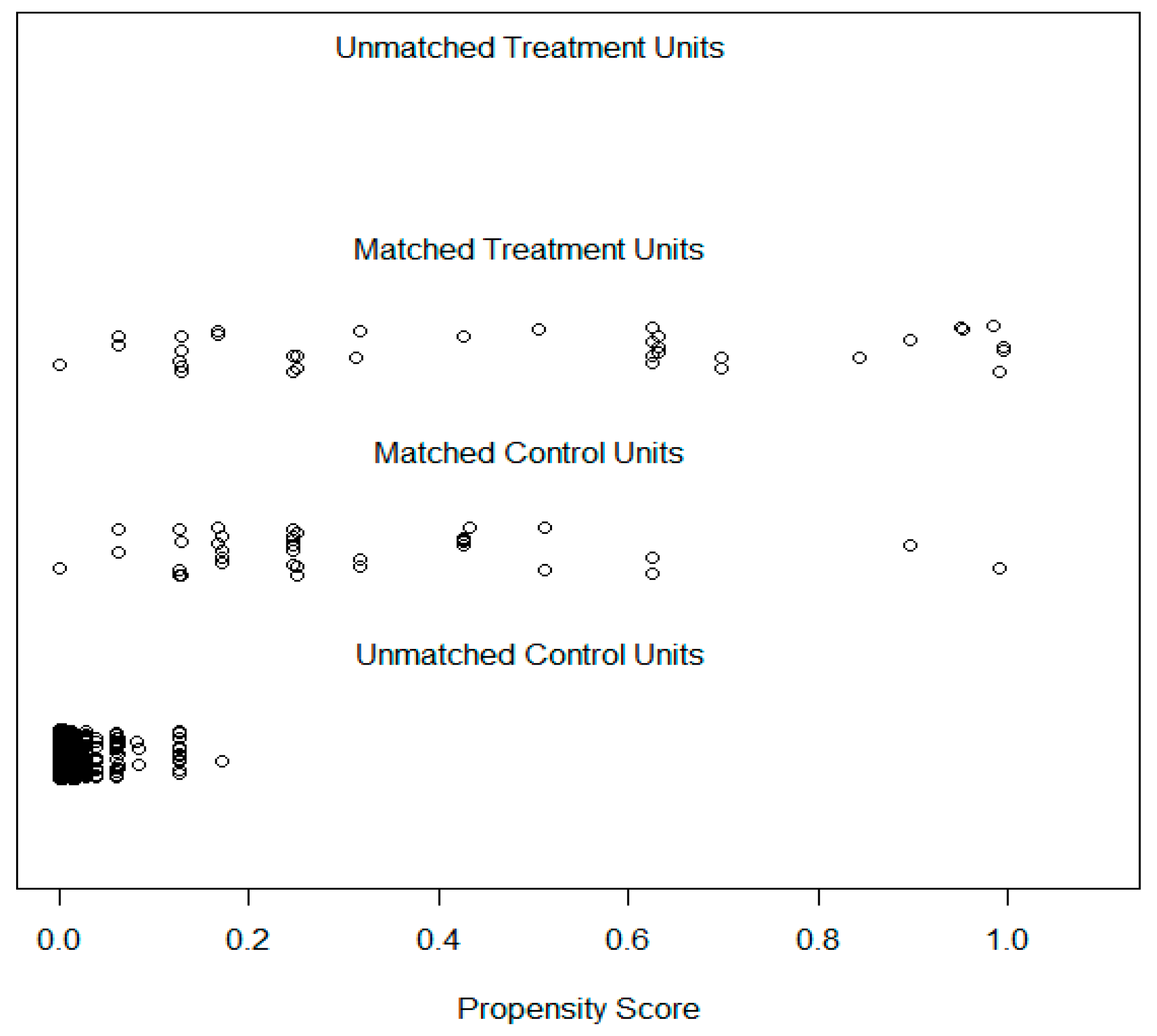Gifted and Talented Services for EFL Learners in China: A Step-by-Step Guide to Propensity Score Matching Analysis in R
Abstract
1. Introduction
2. Literature Review
2.1. Gifted and Talented and English as a Foreign Language Education in China
2.2. Evaluation Design Approach and Propensity Score Matching
3. Method
3.1. Research Design
3.2. Variables Included in the Propensity Score Matching Study
3.3. Steps of the Propensity Score Matching Procedure
3.3.1. Step 1: Install R and MatchIt Packages
3.3.2. Step 2: Data Preparation and Importing
3.3.3. Step 3: Perform Propensity Score Matching and Visualize the Results
3.3.4. Step 4: Export the Matched File
3.3.5. Tips for Common Errors
4. Results
5. Discussion and Perspectives
5.1. Application of Propensity Score Matching in an English Talent Program in the English as a Foreign Language Context
5.2. The Impact of an English Talent Program on EFL Students’ English Learning
6. Limitations and Conclusions
Author Contributions
Funding
Conflicts of Interest
Abbreviations
| Acronyms | Name |
| EFL | English as a foreign language |
| PSM | propensity score matching |
| GT | gifted and talented |
| ET | English talent |
| WTO | World Trade Organization |
| CE | College English |
| CET-4 | College English Test Band Four |
| RCT | randomized controlled trial |
| EGP | English for General Purposes |
| ESP | English for Specific Purposes |
| IC | Intercultural Communication |
| NCEE | National College Entrance Examination |
References
- Bolton, K.; Graddol, D. English in China today: The current popularity of English in China is unprecedented, and has been fuelled by the recent political and social development of Chinese society. Engl. Today 2012, 28, 3–9. [Google Scholar] [CrossRef]
- Wang, P. An Evaluative Study of the Effectiveness of Content-Based Instruction as an EFL Approach in China’s Tertiary Education. Ph.D. Thesis, University of Nottingham, Nottingham, UK, 2018. [Google Scholar]
- Liu, Y. Cultivation of Foreign Language Talents Viewed from the Perspective of Educational Ecology. Theory Pract. Lang. Stud. 2015, 5, 2150–2156. [Google Scholar] [CrossRef][Green Version]
- Chan, D.W. Identifying gifted and talented students in Hong Kong. Roeper Rev. 2000, 22, 88–93. [Google Scholar] [CrossRef]
- Chan, D.W. Healthy and Unhealthy Perfectionists Among Academically Gifted Chinese Students in Hong Kong: Do Different Classification Schemes Make a Difference? Roeper Rev. 2010, 32, 88–97. [Google Scholar] [CrossRef]
- Phillipson, S.N. Learning Diversity in the Chinese Classroom: Contexts and Practice for Students with Special Needs; Hong Kong University Press: Hongkong, China, 2007; Volume 1. [Google Scholar]
- Baker, J.A. Depression and Suicidal Ideation among Academically Gifted Adolescents. Gift. Child Q. 1995, 39, 218–223. [Google Scholar] [CrossRef]
- Cao, T.H.; Jung, J.Y.; Lee, J. Assessment in Gifted Education: A Review of the Literature from 2005 to 2016. J. Adv. Acad. 2017, 28, 163–203. [Google Scholar] [CrossRef]
- Chen, X.; Fan, X.; Cheung, H.Y.; Wu, J. The subjective well-being of academically gifted students in the Chinese cultural context. Sch. Psychol. Int. 2018, 39, 291–311. [Google Scholar] [CrossRef]
- Wu, Y. The Examination System in China: The case of Zhongkao Mathematics. In Selected Regular Lectures from the 12th International Congress on Mathematical Education; Springer: Berlin/Heidelberg, Germany, 2015; pp. 897–914. [Google Scholar]
- Rudowicz, E.; Yue, X.D. Concepts of Creativity: Similarities and Differences among Mainland, Hong Kong and Taiwanese Chinese. J. Creat. Behav. 2000, 34, 175–192. [Google Scholar] [CrossRef]
- Bodycott, P.; Lai, A. The Influence and Implications of Chinese Culture in the Decision to Undertake Cross-Border Higher Education. J. Stud. Int. Educ. 2012, 16, 252–270. [Google Scholar] [CrossRef]
- Zhang, Z. Gifted education in China. Cogent Educ. 2017, 4, 1–12. [Google Scholar] [CrossRef]
- Yue, X.D.; Bender, M.; Cheung, C.-K. Who are the Best-Known National and Foreign Creators—A Comparative Study among Undergraduates in China and Germany. J. Creat. Behav. 2011, 45, 23–37. [Google Scholar] [CrossRef]
- Tao, W. Less Classroom Hours of EFL Instruction to Non-English Majors in Chinese Universities Is It a Reason-Based Policy that Provokes No Response? Engl. Lang. Teach. 2019, 12, 170–176. [Google Scholar] [CrossRef][Green Version]
- Ministry of Education of the People’s Republic of China. Chinese Ministry of Education College English Syllabus (for Undergraduate in Liberal Arts); Higher Education Press: Beijing, China, 1986.
- Ministry of Education of the People’s Republic of China. Chinese Ministry of Education College English Syllabus (for Undergraduate in Science and Engineering Majors); Shanghai Foreign Language Education Press: Shanghai, China, 1985.
- Wu, Z. Washback Effects of the Reformed CET-4 on College English Teaching and Learning in China: Students’ Perspectives. Ph.D. Thesis, Indiana University of Pennsylvania, Indiana, PA, USA, 2014. [Google Scholar]
- Rao, Z.; Lei, C. Teaching English as a foreign language in Chinese universities: The present and future: An appropriate way to teach English in China is to balance teaching activities for elaborating linguistic details and developing students’ communicative competence. Engl. Today 2014, 30, 40–45. [Google Scholar] [CrossRef]
- Li, C.; Zhou, T. An Exploratory Study on the Relationship between Demotivation and Academic Fields among Chinese EFL Learners. Arab. World Engl. J. 2017, 8, 42–54. [Google Scholar] [CrossRef]
- Lei, F.; Weiwei, F.; Di, H. Chinese EFL Learners’ Public Speaking Skills: An Investigation of Impromptu Speeches at the “FLTRP Cup” English Speaking Contest in the Light of Communication Models. Chin. J. Appl. Linguist. 2016, 39, 421–439. [Google Scholar] [CrossRef]
- Lucas, S.E. English Public Speaking and the Cultivation of Talents for Chinese College Students. Chin. J. Appl. Linguist. 2013, 36, 163–182. [Google Scholar] [CrossRef]
- Zhang, X.; Ardasheva, Y. Sources of college EFL learners’ self-efficacy in the English public speaking domain. Engl. Specif. Purp. 2019, 53, 47–59. [Google Scholar] [CrossRef]
- Yuen, M.; Chan, S.; Chan, C.; Fung, D.C.; Cheung, W.M.; Kwan, T.; Leung, F.K. Differentiation in key learning areas for gifted students in regular classes: A project for primary school teachers in Hong Kong. Gift. Educ. Int. 2018, 34, 36–46. [Google Scholar] [CrossRef]
- Wallace, B.; Bernardelli, A.; Molyneux, C.; Farrell, C. TASC: Thinking actively in a social context. A universal problem-solving process: A powerful tool to promote differentiated learning experiences. Gift. Educ. Int. 2012, 28, 58–83. [Google Scholar] [CrossRef]
- Chan, C.; Chang, M.; Westwood, P.; Yuen, M. Teaching adaptively: How easy is differentiation in practice? Asia Pac. Educ. Res. 2002, 11, 27–58. [Google Scholar]
- Tomlinson, C. The Differentiated Classroom: Responding to the Needs of All Learners; ASCD: Alexandria, VA, USA, 1999. [Google Scholar]
- Tomlinson, C.A.; Allan, S.D. Leadership for Differentiating Schools and Classrooms; ASCD: Alexandria, VA, USA, 2000. [Google Scholar]
- Wan, S.W. Differentiated instruction: Hong Kong prospective teachers’ teaching efficacy and beliefs. Teach. Teach. 2016, 22, 148–176. [Google Scholar] [CrossRef]
- Morgan, P.L.; Frisco, M.L.; Farkas, G.; Hibel, J. A propensity score matching analysis of the effects of special education services. J. Spec. Educ. 2010, 43, 236–254. [Google Scholar] [CrossRef] [PubMed]
- Lilienfeld, O.S.; McKay, D.; Hollon, S.D. Why randomised controlled trials of psychological treatments are still essential. Lancet Psychiatry 2018, 5, 536–538. [Google Scholar] [CrossRef]
- Deaton, A.; Cartwright, N. Understanding and misunderstanding randomized controlled trials. Soc. Sci. Med. 2018, 210, 2–21. [Google Scholar] [CrossRef] [PubMed]
- Rosenbaum, P.R.; Rubin, D.B. The central role of the propensity score in observational studies for causal effects. Biometrika 1983, 70, 41–55. [Google Scholar] [CrossRef]
- Hong, G.; Raudenbush, S.W. Effects of Kindergarten Retention Policy on Children’s Cognitive Growth in Reading and Mathematics. Educ. Eval. Policy Anal. 2005, 27, 205–224. [Google Scholar] [CrossRef]
- Shadish, W.R.; Cook, T.D.; Campbell, D.T. Experimental and Quasi-Experimental Designs for Generalized Causal Inference; Wadsworth Publishing: Belmont, CA, USA, 2002. [Google Scholar]
- Becker, S.O.; Ichino, A. Estimation of Average Treatment Effects Based on Propensity Scores. Stata J. Promot Commun. Stat. Stata 2002, 2, 358–377. [Google Scholar] [CrossRef]
- R Core Team. R: A Language and Environment for Statistical Computing. Available online: https://www.R-project.org/ (accessed on 2 August 2019).
- Randolph, J.J.; Falbe, K. A step-by-step guide to propensity score matching in R. Practical Assessment. Res. Eval. 2014, 19, 1–6. [Google Scholar]
- Ho, D.; Imai, K.; King, G.; Stuart, E.A. MatchIt: Nonparametric Preprocessing for Parametric Causal Inference. J. Stat. Softw. 2011, 42, 1–28. [Google Scholar] [CrossRef]
- What Works Clearinghouse. WWC Standard Brief for Baseline Equivalence. 2015. Available online: https://ies.ed.gov/ncee/wwc/Docs/referenceresources/wwc_brief_baseline_080715.pdf (accessed on 2 August 2019).
- Brookhart, M.A.; Schneeweiss, S.; Rothman, K.J.; Glynn, R.J.; Avorn, J.; Stürmer, T. Variable selection for propensity score models. Am. J. Epidemiol. 2006, 163, 1149–1156. [Google Scholar] [CrossRef]
- Burden, A.; Roche, N.; Miglio, C.; Hillyer, E.V.; Postma, D.S.; Mc Herings, R.; Overbeek, A.J.; Khalid, J.M.; Van Eickels, D.; Price, D.B. An evaluation of exact matching and propensity score methods as applied in a comparative effectiveness study of inhaled corticosteroids in asthma. Pragmatic Obs. Res. 2017, 8, 15–30. [Google Scholar] [CrossRef] [PubMed]
- Tong, F.; Irby, B.J.; Lara-Alecio, R.; Guerrero, C.; Tang, S.; Sutton-Jones, K.L. The impact of professional learning on in-service teachers’ pedagogical delivery of literacy-infused science with middle school English learners: A randomised controlled trial study in the U.S. Educ. Stud. 2018, 45, 533–553. [Google Scholar] [CrossRef]
- Yuan, Y.; Tangen, D.; Mills, K.A.; Lidstone, J. Learning English pragmatics in China: An investigation into Chinese EFL learners’ perceptions of pragmatics. Electron. J. Engl. Second Lang. 2015, 19, 1–16. [Google Scholar]














| Variable Name | Type | Role |
|---|---|---|
| CET-4 scores | Scale | Dependent variable |
| NCEE scores | Scale | Matching variable |
| Gender | dichotomous | Matching variable |
| Major | dichotomous | Matching variable |
| Condition | dichotomous | Condition variable |
| N | Mean | Std. Deviation | Std. Error Mean | t | p | d | ||
|---|---|---|---|---|---|---|---|---|
| NCEE | ET | 36 | 138.5 | 3.112 | 0.519 | 1.85 | 0.069 | 0.44 |
| Non-ET | 36 | 137.28 | 2.457 | 0.409 |
| Gender | Major | ||||||||
|---|---|---|---|---|---|---|---|---|---|
| Female | Male | Phi | p | Art | Science | Phi | p | ||
| Condition | Non-ET | 18 | 18 | 0.056 | 0.637 | 10 | 26 | 0.032 | 0.789 |
| ET | 16 | 20 | 9 | 27 | |||||
| Condition | N | CET-4 | Std. Deviation |
|---|---|---|---|
| Non-ET | 36 | 520.06 | 39.414 |
| ET | 36 | 557.64 | 36.166 |
| Predictors | Dependent Variable | df | F | p | Partial Eta Squared |
|---|---|---|---|---|---|
| Condition | CET-4 | 1 | 15.069 | <0.001 | 0.179 |
| NCEE | CET-4 | 1 | 1.254 | 0.267 | 0.018 |
© 2019 by the authors. Licensee MDPI, Basel, Switzerland. This article is an open access article distributed under the terms and conditions of the Creative Commons Attribution (CC BY) license (http://creativecommons.org/licenses/by/4.0/).
Share and Cite
Tang, S.; Tong, F.; Lu, X. Gifted and Talented Services for EFL Learners in China: A Step-by-Step Guide to Propensity Score Matching Analysis in R. Data 2019, 4, 119. https://doi.org/10.3390/data4030119
Tang S, Tong F, Lu X. Gifted and Talented Services for EFL Learners in China: A Step-by-Step Guide to Propensity Score Matching Analysis in R. Data. 2019; 4(3):119. https://doi.org/10.3390/data4030119
Chicago/Turabian StyleTang, Shifang, Fuhui Tong, and Xiuhong Lu. 2019. "Gifted and Talented Services for EFL Learners in China: A Step-by-Step Guide to Propensity Score Matching Analysis in R" Data 4, no. 3: 119. https://doi.org/10.3390/data4030119
APA StyleTang, S., Tong, F., & Lu, X. (2019). Gifted and Talented Services for EFL Learners in China: A Step-by-Step Guide to Propensity Score Matching Analysis in R. Data, 4(3), 119. https://doi.org/10.3390/data4030119







